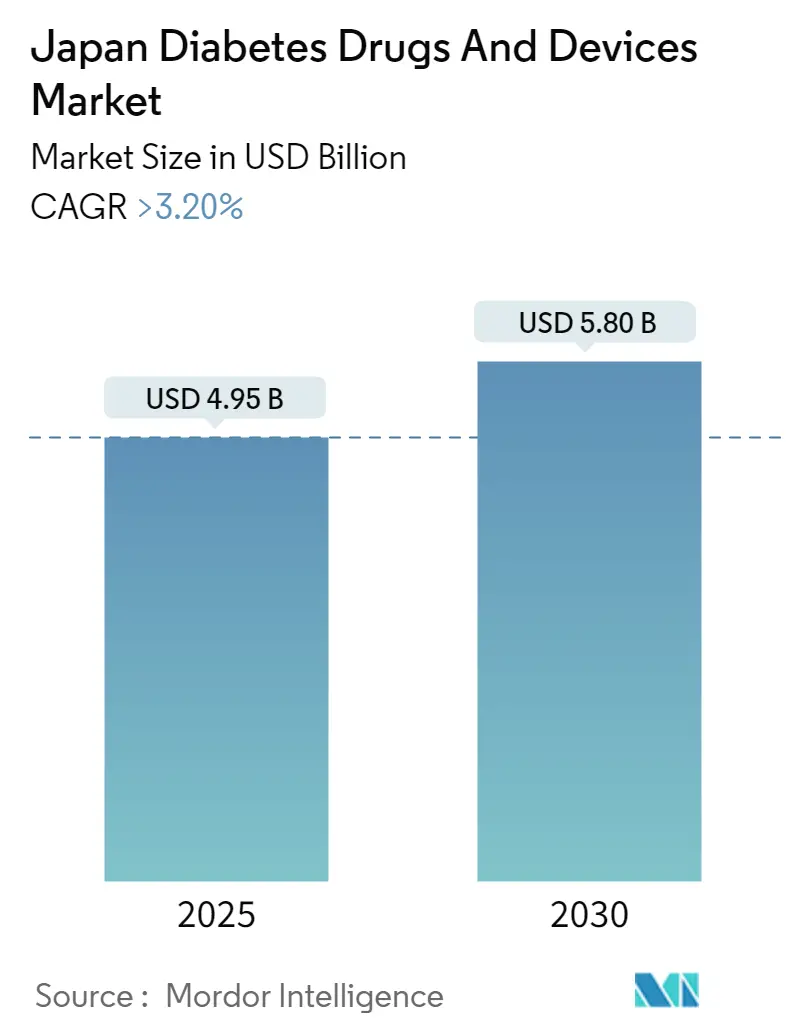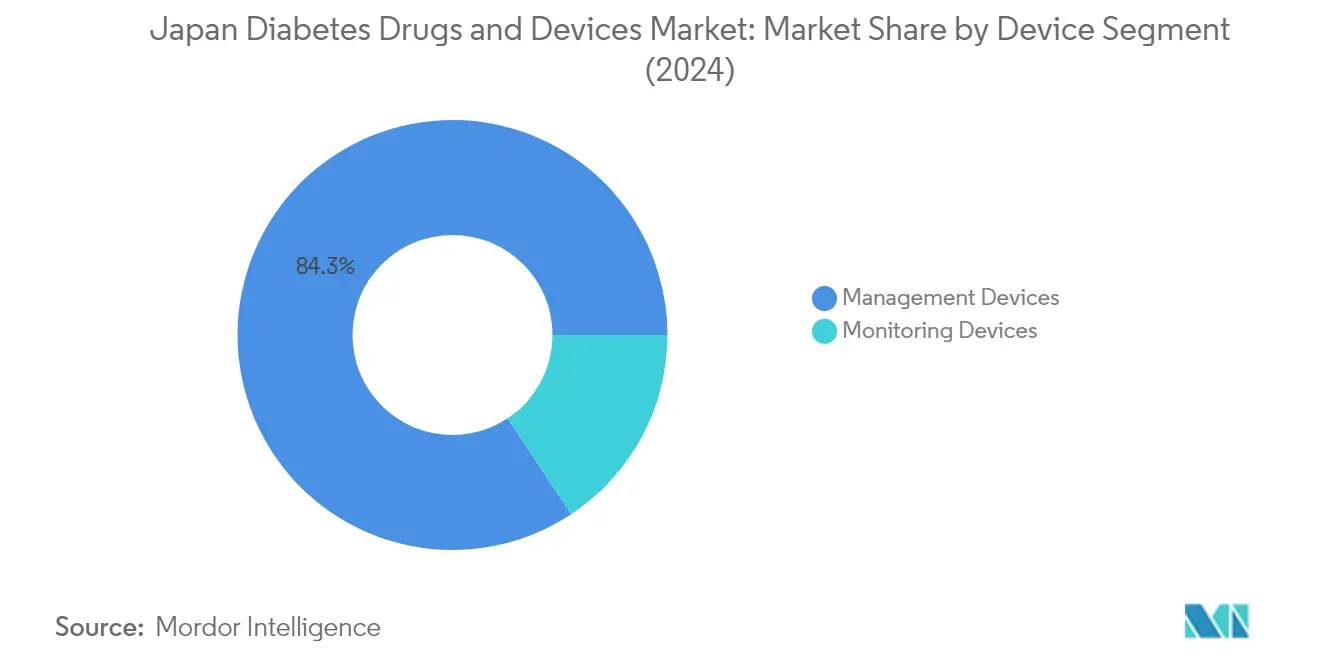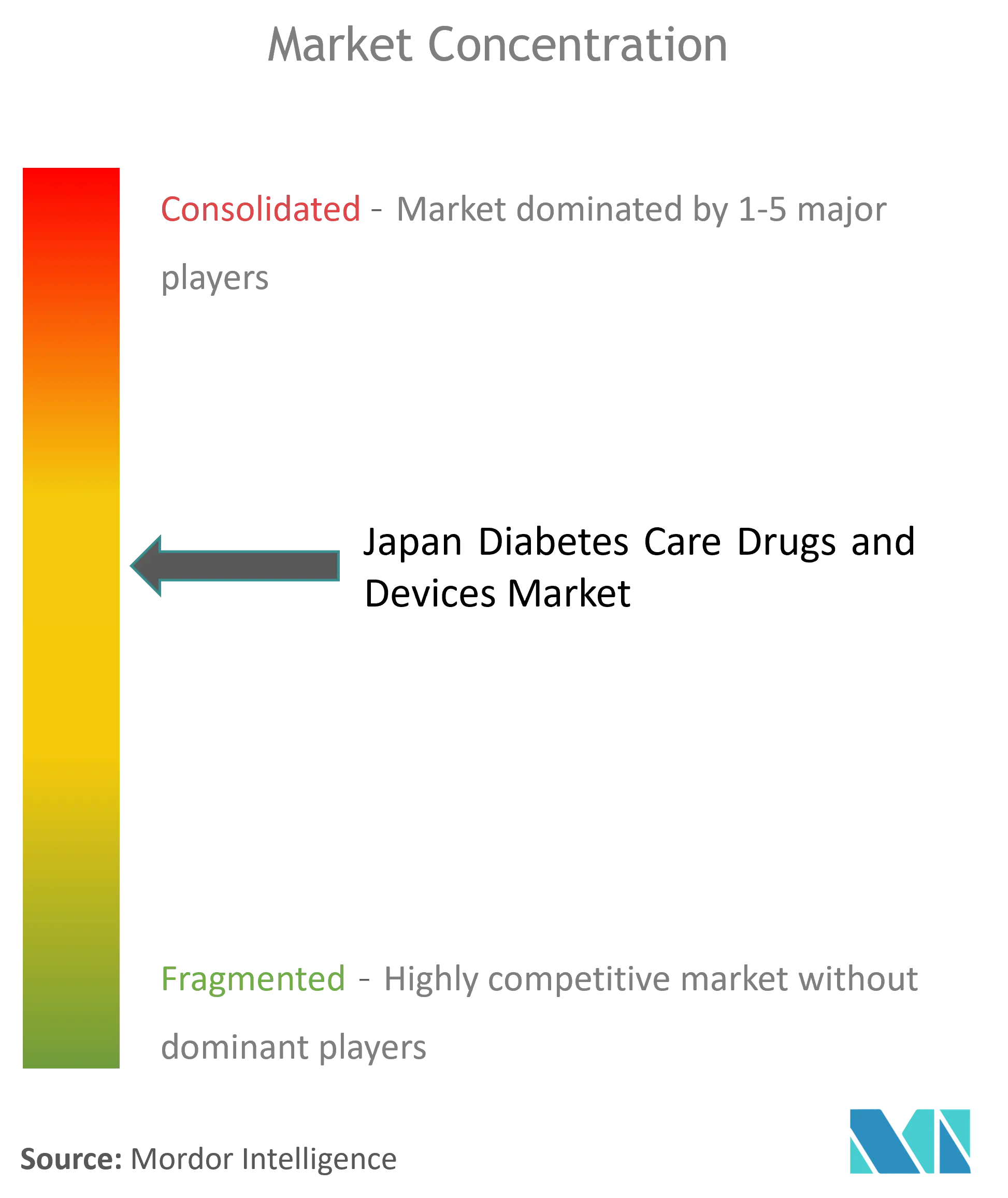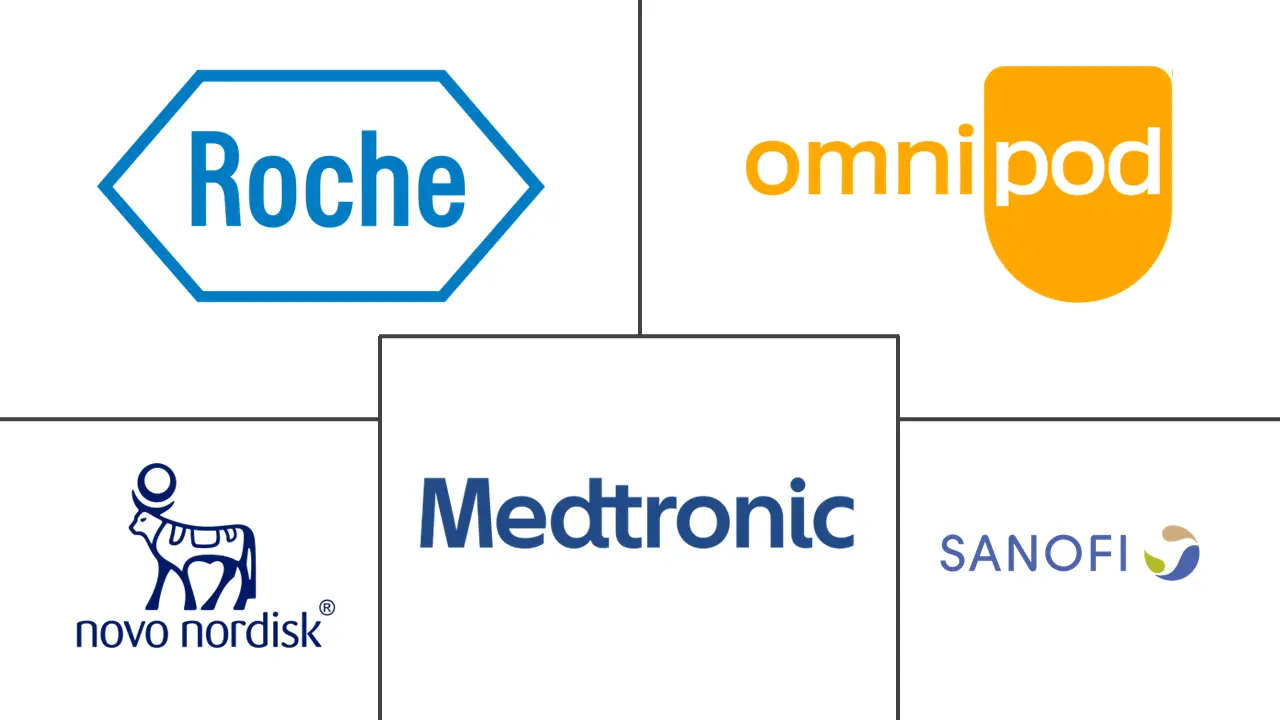Japan Diabetes Drugs And Devices Market Size and Share

Japan Diabetes Drugs And Devices Market Analysis by Mordor Intelligence
The Japan Diabetes Drugs And Devices Market size is estimated at USD 4.95 billion in 2025, and is expected to reach USD 5.80 billion by 2030, at a CAGR of greater than 3.2% during the forecast period (2025-2030).
Japan's diabetes healthcare landscape is undergoing significant transformation driven by demographic shifts and changing lifestyle patterns. The country faces unique challenges with its rapidly aging population, with projections indicating that individuals aged 65 and above will constitute 31.4% of the total population by 2030. This demographic transition is accompanied by increasing urbanization and the adoption of sedentary lifestyles, particularly among the working-age population. According to recent studies, over half of individuals aged 18-44 years with type 2 diabetes in Japan belong to obesity classes I-IV, highlighting the growing concern of lifestyle-related health issues. The convergence of these factors has created a complex healthcare challenge that requires innovative solutions and comprehensive management approaches.
The market is witnessing a significant technological revolution, particularly in the integration of diabetes technology and digital health solutions. In January 2023, Sapporo Medical University announced plans to leverage AI technology for diabetes treatment, utilizing individual patients' healthcare data to enhance treatment outcomes. This technological advancement is complemented by the development of sophisticated monitoring devices and management systems. For instance, in March 2023, Health2Sync partnered with Biocorp to integrate insulin data from Mallya Cap into their latest app version, demonstrating the industry's move toward connected healthcare solutions.
The Japanese healthcare system continues to evolve its reimbursement policies to improve access to advanced diabetes management solutions. A notable development occurred in May 2023 when the Japanese Ministry of Health, Labor and Welfare approved the expansion of reimbursement coverage for Dexcom G6 to include all people with diabetes who use insulin at least once daily. This policy change has made real-time continuous glucose monitoring accessible to more than a million additional people living with diabetes in Japan. Such developments reflect the healthcare system's commitment to embracing innovative technologies while ensuring broader accessibility.
Recent epidemiological data from the International Diabetes Federation indicates that diabetes prevalence in Japanese adults stands at approximately 11.8%, affecting about 11 million adults as of 2022. This significant disease burden has prompted a shift in healthcare delivery models, with an increasing emphasis on preventive care and early intervention strategies. Healthcare providers are adopting more personalized approaches to diabetes management, incorporating factors such as genetic predisposition, lifestyle patterns, and individual response to treatments. This evolution in care delivery is supported by the integration of digital health platforms, remote monitoring capabilities, and patient engagement tools, creating a more comprehensive and patient-centric approach to diabetes management. The focus on advancements in diabetes pharmaceuticals and antidiabetic drugs is central to these efforts, ensuring effective treatment options are available.
Japan Diabetes Drugs And Devices Market Trends and Insights
Rising Prevalence of Diabetes Fostering Research and Treatment
The increasing prevalence of diabetes in Japan, driven by various genetic and environmental factors including overeating, lack of physical activity, and resultant obesity, is creating an urgent need for enhanced research and treatment options. According to the International Diabetes Federation's 2022 reports, approximately 11.8% of adults in Japan (about 11 million individuals) were affected by diabetes, highlighting the significant scale of this health challenge. This situation is further complicated by Japan's aging population, with those aged 65 and above comprising 30.1% of the total population in 2023, expected to reach 31.4% by 2030. The elderly population typically experiences more advanced stages of the disease and often receives insufficient treatment, necessitating the development of more effective therapeutic approaches and monitoring devices, including antidiabetic drugs and insulin delivery devices.
The growing burden of obesity-related diabetes is particularly concerning, with recent studies published in Diabetes Therapy (February 2024) indicating that more than half of individuals aged 18-44 years with type 2 diabetes in Japan belong to obesity class I-IV or central obesity, often exhibiting poor glycemic control with HbA1c levels ≥ 7%. This trend has spurred significant technological advancements, exemplified by developments like Provigate Inc.'s innovative blood glucose monitoring device focusing on glycated albumin (GA) biomarkers. Additionally, companies are actively pursuing research and development initiatives, as demonstrated by the March 2023 integration of Health2Sync's app with Novo Nordisk's Mallya Cap insulin monitoring system, showcasing the industry's commitment to developing more sophisticated and user-friendly diabetes technology and diabetic care products.
Government Support Initiatives to Constrict the Spread of Diabetes
The Japanese government has implemented comprehensive support initiatives and programs aimed at controlling diabetes through effective preventive strategies, screening programs, and awareness campaigns. The Health Promotion Law, enforced in 2003, mandates universal medical care insurance coverage and regular health checkups, with approximately 50% of adults undergoing annual health screenings through workplace or community programs. These systematic screening efforts have been crucial in identifying high-risk individuals early, enabling timely intervention and treatment. Furthermore, the Ministry of Health, Labor and Welfare has established specialized programs like the Diabetic Nephropathy Aggravation Prevention Program (DNAPP), which focuses on preventing the progression of diabetic complications and optimizing healthcare costs.
Recent developments in government support have included significant expansions in reimbursement coverage for advanced diabetes management technologies. For instance, in December 2022, the Japanese medical insurance system introduced a new category titled "C150," extending coverage for continuous glucose monitoring devices to all individuals requiring daily insulin self-injection. This was followed by similar expansions in May 2023, when the Ministry of Health, Labor and Welfare approved broader reimbursement coverage for various CGM devices, making these advanced monitoring solutions accessible to over a million additional people living with diabetes in Japan. These initiatives, combined with the government's commitment to diabetes education and patient-centric care, demonstrate a comprehensive approach to addressing the growing challenges of diabetes management in the country.
Segment Analysis: By Devices
Management Devices Segment in Japan Diabetes Drugs and Devices Market
Management devices dominate the Japan diabetes drugs and devices market, commanding approximately 84% of the market share in 2024. This significant market presence is attributed to the segment's comprehensive portfolio of products, including insulin delivery devices, insulin syringes, insulin cartridges, and diabetes pen devices. The segment's dominance is particularly driven by diabetes pen devices, which hold the largest share within management devices due to their convenience and growing adoption among diabetes patients in Japan. The robust availability of companies offering diabetes pen devices and other management devices, coupled with technological advancements in insulin delivery devices systems, has further strengthened this segment's position in the market. Additionally, the increasing diabetes population in Japan and the rising demand for efficient insulin delivery systems have contributed to the segment's substantial market share.

Monitoring Devices Segment in Japan Diabetes Drugs and Devices Market
The monitoring devices segment is emerging as the fastest-growing category in the Japan diabetes drugs and devices market, with a projected growth rate of approximately 9% during 2024-2029. This accelerated growth is primarily driven by the increasing adoption of continuous glucose monitoring (CGM) systems and self-monitoring blood glucose devices. The expansion of reimbursement coverage for CGM devices, such as the Dexcom G6, by the Japanese medical insurance system has significantly contributed to this growth trajectory. Technological advancements in monitoring devices, including the integration of artificial intelligence and improved accuracy in glucose measurement, are further propelling the segment's growth. The rising focus on preventive healthcare and the growing preference for continuous glucose monitoring among diabetes patients have also been key factors driving the segment's rapid expansion in the Japanese market.
Segment Analysis: By Drugs
Oral Anti-Diabetes Drugs Segment in Japan Diabetes Drugs and Devices Market
The oral antidiabetic drugs segment dominates the Japan diabetes drugs and devices market, commanding approximately 76% market share in 2024. This substantial market presence is attributed to the increasing prevalence of type 2 diabetes in Japan and the growing preference for oral medications among patients. The segment's growth is further supported by the consistent prescription patterns of biguanides, dipeptidyl peptidase-4 inhibitors, and sodium-glucose cotransporter 2 inhibitors among Japanese healthcare providers, aligning with current guideline recommendations. The segment's dominance is also reinforced by the low cost and easy-to-consume nature of oral medications, making them the preferred choice for both healthcare providers and patients in managing diabetes.
Non-Insulin Injectable Drugs Segment in Japan Diabetes Drugs and Devices Market
The non-insulin injectable drugs segment is projected to exhibit the highest growth rate of approximately 6% during the forecast period 2024-2029. This accelerated growth is primarily driven by the increasing adoption of GLP-1 receptor agonists and their proven effectiveness in managing type 2 diabetes. The segment's growth is further bolstered by recent developments such as the launch of Mounjaro subcutaneous injection by Eli Lilly Japan and Mitsubishi Tanabe Pharma Corporation in 2023. The effectiveness of once-weekly semaglutide in Japanese patients with type 2 diabetes mellitus, particularly in cases where other therapies have not achieved target reduction in HbA1c levels, has significantly contributed to the segment's expansion.
Remaining Segments in Japan Diabetes Drugs Market
The insulin drugs and combination drugs segments continue to play vital roles in the Japanese diabetes drugs market. The insulin drugs segment maintains its significance through established products like Lantus XR and Toujeo, particularly among elderly patients and those with longer disease duration. Meanwhile, the combination drugs segment offers comprehensive glucose control solutions through fixed-dose combinations, such as iGlarLixi, which has shown promising results in Japanese patients who require treatment intensification. These segments complement the overall market by providing diverse treatment options for different patient populations and specific therapeutic needs.
Competitive Landscape
Top Companies in Japan Diabetes Drugs and Devices Market
The competitive landscape is characterized by the strong presence of both global pharmaceutical giants and medical device specialists who are actively investing in product innovation and market expansion. Companies are focusing on developing advanced pharmaceutical management for diabetes solutions that integrate digital technologies, artificial intelligence, and connected devices to provide comprehensive care options. Strategic partnerships between pharmaceutical companies and technology firms are becoming increasingly common to enhance product offerings and market reach. The market players are emphasizing the development of user-friendly devices and more effective insulin delivery systems, while simultaneously working on expanding their distribution networks and improving market access through reimbursement coverage. There is also a notable trend towards localization of products and services to better serve the specific needs of the Japanese healthcare system and patient population.
Market Dominated by Global Healthcare Conglomerates
The Japanese diabetes drugs and devices market exhibits a relatively consolidated structure, with major global healthcare conglomerates holding significant market positions through their established presence and comprehensive product portfolios. These companies leverage their extensive research and development capabilities, robust distribution networks, and strong financial resources to maintain their competitive advantage. Local players, while present in the market, primarily operate through partnerships and licensing agreements with global leaders, contributing to the market's collaborative nature.
The market demonstrates a dynamic environment for mergers and acquisitions, with companies actively seeking to strengthen their market position through strategic consolidations and technology acquisitions. Global players are increasingly focusing on acquiring local companies or forming joint ventures to enhance their understanding of the Japanese market and improve their distribution capabilities. This trend is particularly evident in the diabetes devices segment, where technological advancement and innovation are key drivers of market growth.
Innovation and Localization Drive Market Success
Success in the Japanese diabetes drugs and devices market increasingly depends on companies' ability to innovate while adapting to local healthcare needs and regulatory requirements. Market incumbents are focusing on developing integrated technology management for diabetes solutions that combine drugs, devices, and digital platforms to provide comprehensive care options. Companies are also investing in building strong relationships with healthcare providers and ensuring compliance with Japan's stringent quality and safety standards while working closely with regulatory authorities to secure timely approvals for new products.
For new entrants and growing players, success lies in identifying and addressing specific market gaps while developing strategic partnerships with established players to leverage existing distribution networks. Companies need to demonstrate clear therapeutic advantages or technological innovations that align with the Japanese healthcare system's focus on preventive care and patient monitoring. The regulatory environment, while challenging, provides opportunities for companies that can navigate it effectively while maintaining high quality standards and building trust with healthcare providers and patients. The development of products for diabetic care that meet these criteria is crucial for gaining a competitive edge.
Japan Diabetes Drugs And Devices Industry Leaders
-
Novo Nordisk A/S
-
Medtronic
-
Insulet Corporation
-
Sanofi
-
Eli Lilly and Company
- *Disclaimer: Major Players sorted in no particular order

Recent Industry Developments
- February 2024: Novo Nordisk Pharma introduced Ugovi Subcutaneous Injection, a once-weekly injection of the GLP-1 receptor agonist semaglutide (recombinant). In Japan, GLP-1 receptor agonists gained approval for treating obesity and type 2 diabetes.
- March 2023: Health2Sync developed the latest version of the Health2Sync App that integrated insulin data from Mallya Cap (insulin cartridge) developed by Biocorp and commercialized in Japan by Novo Nordisk.
Japan Diabetes Drugs And Devices Market Report Scope
Patients with type 1 diabetes must be given insulin because their pancreas cannot process it. To control blood sugar levels, insulin must be given several times a day, such as when eating or drinking. Many people with type 2 diabetes also need to take antidiabetic drugs. These drugs include diabetes medications and injections such as insulin.
Japan's diabetes drugs and devices market is segmented into devices and drugs. By devices, the market is segmented into monitoring devices and management devices. Monitoring devices include self-monitoring blood glucose devices and continuous blood glucose monitoring. Management devices include insulin pumps, insulin syringes, disposable pens, and others. By drugs, the market is segmented into oral anti-diabetes drugs, insulin drugs, and others. For each segment, the market sizing and forecasts were made on the basis of revenue (USD).
| Devices | Monitoring Devices | Self-Monitoring Blood Glucose Devices |
| Continuous Blood Glucose Monitoring | ||
| Management Devices | Insulin Pump | |
| Insulin Syringes | ||
| Disposable Pens | ||
| Others | ||
| Drugs | Oral Anti-diabetes Drugs | |
| Insulin Drugs | ||
| Others | ||
| By Product Type | Devices | Monitoring Devices | Self-Monitoring Blood Glucose Devices |
| Continuous Blood Glucose Monitoring | |||
| Management Devices | Insulin Pump | ||
| Insulin Syringes | |||
| Disposable Pens | |||
| Others | |||
| Drugs | Oral Anti-diabetes Drugs | ||
| Insulin Drugs | |||
| Others | |||
Key Questions Answered in the Report
How big is the Japan Diabetes Drugs And Devices Market?
The Japan Diabetes Drugs And Devices Market size is expected to reach USD 4.95 billion in 2025 and grow at a CAGR of greater than 3.20% to reach USD 5.80 billion by 2030.
What is the current Japan Diabetes Drugs And Devices Market size?
In 2025, the Japan Diabetes Drugs And Devices Market size is expected to reach USD 4.95 billion.
Who are the key players in Japan Diabetes Drugs And Devices Market?
Novo Nordisk A/S, Medtronic, Insulet Corporation, Sanofi and Eli Lilly and Company are the major companies operating in the Japan Diabetes Drugs And Devices Market.
What years does this Japan Diabetes Drugs And Devices Market cover, and what was the market size in 2024?
In 2024, the Japan Diabetes Drugs And Devices Market size was estimated at USD 4.79 billion. The report covers the Japan Diabetes Drugs And Devices Market historical market size for years: 2019, 2020, 2021, 2022, 2023 and 2024. The report also forecasts the Japan Diabetes Drugs And Devices Market size for years: 2025, 2026, 2027, 2028, 2029 and 2030.
Page last updated on:



